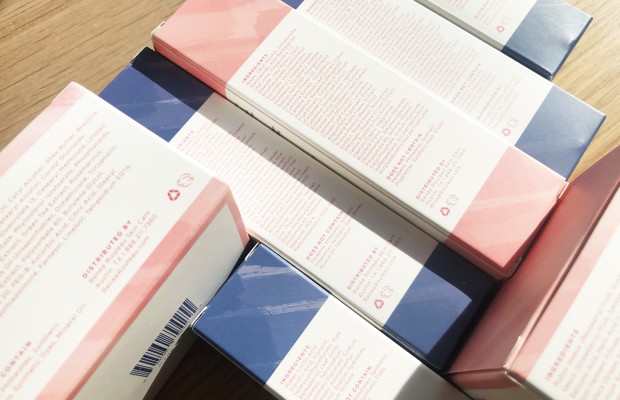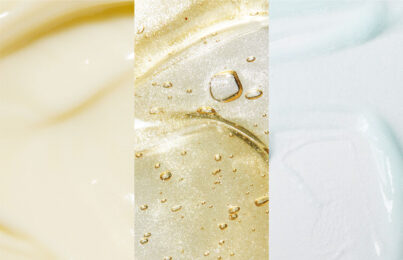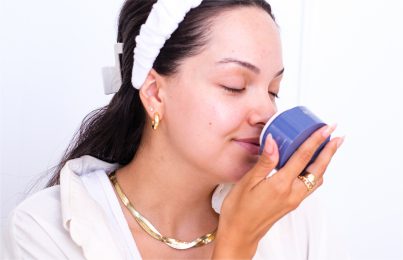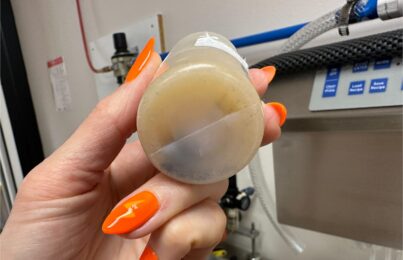Updated 07/07/21. Now more than ever, consumers are educating themselves on skincare ingredient lists, so they can make informed decisions about the safety and efficacy of the products they use. While they’re important to reference, skincare ingredient lists can be confusing and misleading. That’s why I’m here. As an esthetician and product formulator with 30 years of experience, I know that skincare formulations are never black and white and oftentimes, more isn’t necessarily better. Keep reading to learn everything you need to know about skincare ingredient percentages.
The “First Five” Rule
When reading a skincare ingredient list, many people follow the First Five Rule. This rule claims that because the first five ingredients listed on a label have the highest percentages, they are ultimately what determines the true performance of a product. Those who follow this rule claim that any ingredients listed after the first five won’t have a meaningful effect on the skin, because they are included at too low a percentage to perform. While it’s true that ingredients are generally listed in order of highest to lowest concentration, skincare formulations are incredibly nuanced. In fact, it’s almost impossible to tell how well an ingredient will perform based on where it falls in the ingredient label (more on that later).
The INCI List
INCI stands for International Nomenclature of Cosmetic Ingredients. It’s a standardized system for listing ingredient names on cosmetic product labels. Because an ingredient can have different names depending on the country, using a standardized system eliminates confusion and makes international trade easier. INCI has been in place since the 1970s and is used in many major countries, including the USA, China, Japan, and all of the European Union. If you’ve ever wondered why the ingredients on your product label are listed under their scientific names, well now you know!
Here are a few more facts about skincare ingredient lists:
- According to INCI, a skincare brand is required to print the ingredients on the packaging in the order of highest to lowest concentration.
- Once it gets to ingredients that are included at a concentration of 1% or less, they no longer have to be in order.
- The first ingredient in any skincare product is usually water or aloe (which is mostly made up of water). These often make up 70%–95% of the product, which is perfectly acceptable.
- After that, the next four ingredients are typically included at concentrations of anywhere between 3-5%.
- After the first five ingredients, you can still find many performance-based active ingredients, along with thickeners, preservatives, fillers, and everything else that makes up a skincare product.
When a product formulator is determining which percentage of an ingredient should be used, the ingredient is carefully considered based on information provided by the ingredient supplier, including the recommended use level for optimum safety and performance, the range of use levels that achieve different results, and the clinically tested level based on exact percentage.
Why The “First Five” Rule Isn’t Always Right
To make a long story short, an ingredient doesn’t have to be listed within the top five to have a positive impact on the skin. In fact, the first five ingredients typically make up the format of a product—for example, the first five ingredients in a cream are typically the ingredients that make it a cream. This doesn’t mean the First Five Rule never applies, but there are many exceptions to this rule. Below, I’ve listed some skincare ingredients that may or may not be listed within the top five on the label and may or may not be in a concentration of less than 1% but can still be very effective either way.
Examples of Skincare Ingredient That Don’t Require a High Percentage to Work
Antioxidants
There are many antioxidants that can be quite potent in small doses, but before we talk about them, we need to talk about the complexity of skin cell protection. Did you know that using just one type of antioxidant at a high percentage won’t adequately protect the skin against the many forms of ROS and RNS (free radicals) that can contribute to premature cell aging? For comprehensive protection, the skin needs a variety of antioxidants. This could easily push some of these ingredients down past the top five, but that certainly doesn’t mean that the skin isn’t benefitting from them.
Two good examples are lipochroman-6 and astaxanthin. These antioxidants should only be used in concentrations of a fraction of a percentage, which means they’re normally placed pretty low on the ingredient list. That means if you’re only paying attention to the first five ingredients, you’re completely overlooking the potency of these actives.
Take my Firm + Repair Overnight Serum, for instance. If you’ve ever used it, you’ve seen how it’s bright orange. This is due to astaxanthin, which is listed as the ninth ingredient on the label. Only a small amount is used, yet it delivers a powerful dose of antioxidants to the skin. In fact, astaxanthin gives up to 10 times stronger free-radical protection than beta carotene and 500 times more free-radical protection than vitamin E. It does its job at clinically tested levels of just 0.035%!
Vitamin C
There are so many different kinds of vitamin C, all of which have different recommended use levels depending on which form they are in. This can include acids, alcohols, esters, or liposomal forms. The range is very wide, starting at a fraction of a percent and going up to as much as 20%. On that note, here are five things to look for in a vitamin C formula.
Vitamin A
Like vitamin C, the recommended use level for vitamin A will vary greatly depending on whether it’s in the form of an acid, alcohol, ester, or liposome (for a time-released delivery). This means that percentages will vary greatly. Take retinol (which is a form of vitamin A) for example. Prescription retinoids usually contain a concentration of 0.1% at most, yet they’re known to be much more potent than over-the-counter retinol, which typically contains a much higher percentage. Each form has its benefits and downsides. Read my beginner’s guide to retinol and retinoids.
Glycerin
Glycerin is a powerful humectant that, based on the percentage used, can drastically affect the performance and user experience of a product. A high percentage (one that puts it in the top five of the skincare ingredient list) would make a product feel sticky and would perform best in a serum, whereas a lower percentage that would fall further down on the list would be a nice addition to a toner or essence to maintain a lighter texture.
Peptides
Some peptides have a set level of recommended use that has been determined by clinical testing. For example, most matrixyl peptides have a recommended use level of 2-3%, since most studies have been performed at this level. Other peptides might have a whole range of recommended use levels. This range can be anywhere from 0.5%–10%, depending on the type of peptide.
Niacinamide
Unlike a lot of other active ingredients, niacinamide can have different effects on the skin depending on the percentage at which it’s included in a formula. For example, 0.5% can give the skin an energy boost, whereas 2% can help improve barrier function, boost collagen production, and brighten the skin. A study by the Department of Dermatology at Wake Forest University also showed that niacinamide, at 2%, can help control oil production. At 4%-5%, it has been clinically proven to have significant brightening effects that are on par with a skin bleach called hydroquinone.
Exfoliating Acids (AHA/BHA)
Exfoliating acids can be effective in very small percentages depending on the product’s pH. Some formulas call for a higher percentage of acids, more like what you’d find in a professional chemical peel, but even then, if the manufacturer doesn’t control the product’s pH, the high percentage becomes useless.
Perfumes
Perfumes are usually included at a concentration of less than 1%, which puts them pretty low on the ingredient list. Yet they can be known to cause skin sensitivity. This goes to show that an ingredient doesn’t have to be high on the list to have an effect on your skin.
Plant Stem Cells
Plant stem cells are usually delivered via a liposomal delivery system or through solvents, such as alcohol. This means the same material can have two very different recommended use levels. A solvent can be used in a very small percentage, whereas a liposomal delivery system can require a higher percentage. Regardless, they both work the same.
Preservatives
Preservatives are only used at concentrations of a few tenths of a percent, which brings them almost to the end of the list, but you certainly wouldn’t want to use a product without them if you want your products to be safe. Preservatives prevent harmful microorganisms from growing in products and a low percentage is all that is needed to work.
The Bottom Line
The bottom line is that the percentage at which an ingredient is used in a formula depends on so many factors. For you, the skincare consumer, it’s important to not succumb to the instinct that more is always better. Hopefully, this information will empower you to make better purchasing choices and teach you not to rule out a great product just because it appears to have a low percentage of active ingredients. Casting judgment based solely on the first five ingredients is truly an inaccurate way of evaluating a product’s content and performance.
As a Skincare Formulator, These Are the Things I Consider When Developing a New Product:
- What is the intent of this product?
- What skincare problem am I looking to solve with this product?
- What ingredients, aside from the top five, am I trying to incorporate into the formula for combined benefits?
- What percentages of ingredients are necessary for utmost efficacy in the formula?
- What delivery vehicles do I want to use to get the ingredients into the skin so they can go to work?
- How are the ingredients stabilized?
- What does the formula taste like? (As I mentioned in this post, I use my tongue to determine certain traits of a product—specifically products that contain acids, such as vitamin C (ascorbic acid), glycolic acid, lactic acid, etc. I dip my finger into the product and place a tiny dab on my tongue. If it’s super acidic and tastes really sour similar to pure lemon, then I know it has a high acid content. If it barely tastes sour at all, I know there’s not much acid in it. Basically, I can tell whether a product has a decent amount of an acid in it by the intensity of the sourness I taste. I don’t recommend that others do this; this is simply one of the tools I use to get a quick first impression of a product.)
As a product formulator, this is a very exciting time, as new technology is becoming available at an incredible rate. We are also dealing with serious science at the intersection of product chemistry and skin biochemistry. It’s in our best interest to gain a thorough understanding of the powerful tools that product manufacturers are putting in our hands. Then, and only then, will we truly appreciate the vast possibilities for the treatment of skin imperfections through innovative product development.
Why I Choose Not to Disclose Ingredient Percentages In My Product Line
Some brands share ingredient percentages as part of their unique selling position in the market, so they have a point of difference from their competitors. This doesn’t mean that the product will necessarily be more effective, as ingredient percentages are not the only element of efficacy. If someone says to you, “…that ingredient is only effective at _____%”, this is simply not always an accurate statement. As for my line, I choose not to disclose percentages, as they make up proprietary formulas that are part of our company’s intellectual property. However, I can assure you that each product I develop has my stamp of approval creating positive change within the skin. To put it simply, my products work, and I’m super proud that Renée Rouleau Skin Care has a proven track record of 25 years!
The best advice I can give you is to shop from brands that put a premium on integrity. If a brand cares about these values, chances are they’ll put a lot of effort into ensuring their products are well-formulated. Unfortunately, anyone can tell you anything, and the only way you can truly test the efficacy of a product’s formulation is to take it to a lab.
Next, read up on “clean beauty” and the safety of skincare ingredients.
Celebrity Esthetician & Skincare Expert
As an esthetician trained in cosmetic chemistry, Renée Rouleau has spent 35 years researching skin, educating her audience, and building an award-winning line of products. Her hands-on experience as an esthetician and trusted skin care expert has created a real-world solution — products that are formulated for nine different types of skin so your face will get exactly what it needs to look and feel its best. Trusted by celebrities, editors, bloggers, and skincare obsessives around the globe, her vast real-world knowledge and constant research are why Marie Claire calls her “the most passionate skin practitioner we know.”




Comments:
This post really opened my eyes to the importance of understanding ingredient lists! I always assumed if a product was popular, it must be good for my skin. Now I know to look beyond the marketing hype and be more discerning about the products I choose. Thanks for the insights!
Posted By: NEKOPOI APK |
Very very informative article, such a nice explanation and suggestions for a property seeker thank you so much for your kind efforts, we are very thankful to you.
Posted By: iktaaromatics |
I’ve struggled with finding the right skincare product for years, but your tips have helped me figure it out. Thank you!
Posted By: Vilvah |
Could you please tell me what TEA-Stearate does to the skin and whether its okay for the skin? I’m getting mixed information online so I’m a bit confused. I’m not sure this is any help, but its the 6th ingredient in the lotion i’m looking at.
Thank you. 🙂
Posted By: Zohal Gudaz |
Hello! This is an emulsifying ingredient. This helps keep oils and water mixed properly in the moisturizer.
Posted By: Renée Rouleau |
What are the percentages of niacinamide in Sheer Moisture and Skin Correcting serum?
Posted By: Ashly |
Thank you for your interest in our products! Our company does not disclose the percentages of ingredients in all of our products. Our ingredient concentrations are intentionally selected to work in harmony with one another. In developing our formulations, we create proprietary ingredient blends to deliver optimal efficacy and results and thoroughly test each product for irritation on all skin types and also test them in conjunction with our other products to ensure safety and synergies.
Thank you so much for your understanding!
Posted By: Renée Rouleau |